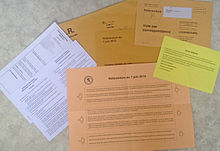
Back تصويت بريدي Arabic Vot per correu Catalan Korespondenční hlasování Czech Brevstemme Danish Briefwahl German Επιστολική ψήφος Greek Voto por correo Spanish رای پستی Persian Vote postal French הצבעה בדואר HE

| Part of the Politics series |
| Voting |
|---|
|
|

Postal voting is voting in an election where ballot papers are distributed to electors (and typically returned) by post, in contrast to electors voting in person at a polling station or electronically via an electronic voting system.
In an election, postal votes may be available on demand or limited to individuals meeting certain criteria, such as a proven inability to travel to a designated polling place. Most electors are required to apply for a postal vote, although some may receive one by default. In some elections postal voting is the only voting method allowed and is referred to as all-postal voting. With the exception of those elections, postal votes constitute a form of early voting and may be considered an absentee ballot.
Typically, postal votes must be mailed back before the scheduled election day. However, in some jurisdictions return methods may allow for dropping off the ballot in person via secure drop boxes or at voting centers. Postal votes may be processed by hand or scanned and counted electronically. The history of postal voting dates back to the 19th century, and modern-day procedures and availability vary by jurisdiction. Research, focused on the United States and using data from states where postal voting is widely available—California, Oregon and Washington—shows that the availability of postal voting tends to increase voter turnout.[1][2][3]
Electoral laws typically stipulate a series of checks to protect against voter fraud and allow for the integrity and secrecy of the submitted ballot to be maintained. Known instances of fraud are very rare.[4] Coordinated, large-scale fraud by postal voting is likely hard to pull off undetected because the large number of interested parties (such as officials, political operators, and journalists) as well as a large number of scholars and analysts who are capable of detecting statistical outliers in vote totals signifying large-scale fraud.[2] Officials can confirm instances of fraud by checking signatures and conducting basic detective work.[2]
- ^ Hill, Charlotte; Grumbach, Jacob; Bonica, Adam; Jefferson, Hakeem (2020). "We Should Never Have to Vote in Person Again". The New York Times. ISSN 0362-4331. Archived from the original on 2020-12-03. Retrieved 2020-05-17.
- ^ a b c Wines, Michael (2020-05-25). "Which Party Would Benefit Most From Voting by Mail? It's Complicated". The New York Times. ISSN 0362-4331. Archived from the original on 2020-12-11. Retrieved 2020-05-28.
- ^ Thompson, Daniel M.; Wu, Jennifer A.; Yoder, Jesse; Hall, Andrew B. (2020-06-09). "Universal vote-by-mail has no impact on partisan turnout or vote share". Proceedings of the National Academy of Sciences. 117 (25): 14052–14056. Bibcode:2020PNAS..11714052T. doi:10.1073/pnas.2007249117. ISSN 0027-8424. PMC 7322007. PMID 32518108.
- ^ Qvortrup, Matt (2005). "First past the Postman: Voting by Mail in Comparative Perspective". The Political Quarterly. 76 (3): 414–419. doi:10.1111/j.1467-923X.2005.00700.x. ISSN 1467-923X.